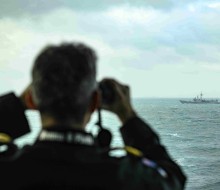
NZDF bolsters North Korea sanctions enforcement with HMNZS Aotearoa and P-8A Poseidon
08 December 2025
Unfortunately you are viewing this website on an outdated browser which does not support the necessary features for us to provide an adequate experience. Please switch to a modern browser such as latest version of Google Chrome, Mozilla Firefox, Apple Safari or Microsoft Edge.
Ngā mihi nui
Learning to engage and work with the maritime industry falls to the Naval Reserve Force specialists, the Maritime Trade Operators (MTOs).
There’s plenty of room at sea, but it can still get crowded. The Royal New Zealand Navy needs to conduct combat training and exercises, but merchant shipping – which accounts for 99 percent of all trade arriving in, and departing from, New Zealand – needs to flow without interruption.
Keeping merchant masters advised of issues, dangers and places to avoid relies on specialists in the Naval Reserve Force, the Maritime Trade Operators (MTO).
Several times a year, the Navy’s MTOs conduct Exercise Manaia, to introduce new MTO officers and sailors to their roles and give them opportunities to shadow experienced personnel. Naval Reserve units HMNZS Ngapona (Auckland and Tauranga), HMNZS Olphert (Wellington), HMNZS Pegasus (Christchurch) and HMNZS Toroa (Dunedin) take part.
Lieutenant Commander Gerad Chaplin, Officer In Charge for the exercise participants at Olphert, says the exercise focuses on shipping technology and procedures as well as how to engage and work with maritime industry.
“The Navy needs to operate their warfighting platforms but could be doing so in the same areas as merchant shipping. It might also be that the Navy needs commercial shipping for logistics support, such as replenishment, and will need to know about port infrastructure if diverted to a port.”
The most recent Exercise Manaia ran for three days in May 2025.
“There’s a wide range of activities. Here in Wellington we conducted desk-top exercises, testing equipment, and it was an opportunity to introduce two new MTO officers into what goes on within the trade.”
It included maritime industry engagement, with a visit to the Rescue Coordination Centre.
“That centre has a lot of engagement with NZDF, maritime and aviation. One of our members on the exercise had worked there previously, and a current member is working there full time, so there’s a really close connection.”
The Tauranga sub-unit of HMNZS Ngapona is based at the port of Tauranga and, according to LTCDR Chaplin, has more opportunities for merchant shipping exposure.
“At the port headquarters there, the Tauranga team there can step out of the unit, walk across the wharf and select a ship. I’ve done it myself in the past. You basically walk to the ship, step off the ship, go down to the next one.”
Ordinary Maritime Trade Operator Michael Bresler is both a civilian at New Zealand Defence Force and a Naval Reservist at Olphert. He saw the Reserves as an opportunity to complement his day job and provide a better understanding of the uniform side of NZDF.
“I’ve enjoyed learning more about shipping and the maritime industry, something I knew very little about before joining the Navy.”
This was his fourth Exercise Manaia.
“For this exercise I was the communications operator, sending and receiving all primary comms between our Wellington team and the exercise headquarters and other units around New Zealand. I’d update the Comms log, incident log, data storage sites, and keep my 1-up informed about important communications. In previous exercises I’ve compiled briefing packs and helped track merchant vessels.”
OMTO Bresler says MTO capability in New Zealand is still developing.
“It’s important because being able to understand the merchant shipping picture in our Exclusive Economic Zone is critical to providing a safe and secure maritime environment.
“Our MTO work provides that clear picture and this can be provided to Joint Forces Headquarters, the Navy and other government agencies. At the same time, we’re an important go-between for the Navy – the ‘grey’ fleet – and merchant shipping – the ‘white’ fleet.”
These exercises are a build-up to larger-scale international MTO exercises, where the RNZN trains to operate with allies and partners to achieve the same contribution to global maritime security.